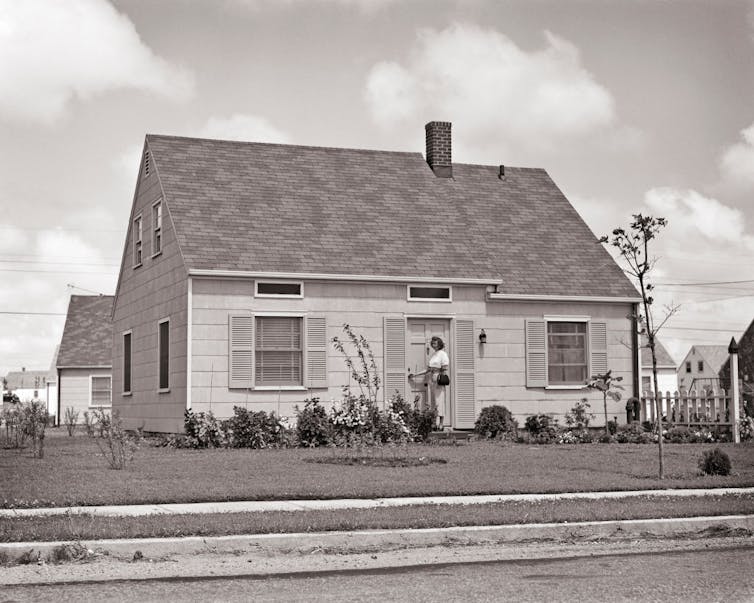To paint or not to paint?
That is the question that many homeowners are facing as their dreams for perfect turf are battered – whether it’s from inflation pushing pricier lawn care options out of reach, or droughts leading to water shortages.
Increasingly, many are turning in the spreader for the paint can, opting, according to a report in The Wall Street Journal, for shades of green with names like “Fairway” and “Perennial Rye.”
Where does this yen for turning the outside of the house into a trim green carpet come from?
Some years ago, I decided to investigate and the result was my book “American Green: The Obsessive Quest for the Perfect Lawn.”
What I found was that lawns extend far back in American history. Former presidents George Washington and Thomas Jefferson had lawns, but these were not perfect greenswards. It turns out that the ideal of perfect turf – a weed-free, supergreen monoculture – is a recent phenomenon.
The not-so-perfect lawns of Levittown
Its beginnings can largely be traced to the post–World War II era when suburban developments such as the iconic Levittown, New York, had its start.
Levittown was the brainchild of the Levitt family, which viewed landscaping – a word that only entered the English language in the 1930s – as a form of “neighborhood stabilization,” or a way of bolstering property values. The Levitts, who built 17,000 homes between 1947 and 1951, thus insisted that homeowners mow the yard once a week between April and November and included the stricture in covenants accompanying their deeds.
But the Levitts took the obsession with the lawn only so far. “I don’t believe in being a slave to the lawn,” wrote Abraham Levitt. Clover was, to him, “just as nice” as grass.

Engineering perfection
All of which is to say that the quest for the perfect lawn did not come naturally. It had to be engineered, and one of the greatest influencers in this regard was the Scotts Co. of Marysville, Ohio, which took agricultural chemicals and created concoctions that homeowners could spread over their yards.
Formulators like Scotts had one great advantage: Turfgrass is not native to North America, and growing it on the continent is, for the most part, an uphill ecological battle. Homeowners thus needed a lot of help in the quest for perfection.
But first Scotts had to help lodge the idea of perfect turf in the American imagination. Scotts was able to tap into postwar trends in brightly colored consumer products. From yellow slacks to blue Jell-O, colored products became status symbols and a sign that the consumer had rejected the drab black-and-white world of urban life for the modern suburb and its kaleidoscopic colors – which included, of course, the vibrant green lawn.
Architectural trends also helped the perfect turf aesthetic take root. A blurring of indoor and outdoor space occurred in the postwar era as patios and eventually sliding glass doors invited homeowners to treat the yard as an extension of their family room. What better way to achieve a comfy outdoor living space than to carpet the yard in a nice greensward.
In 1948, the perfect lawn took a giant step forward when the Scotts Co. began selling its “Weed and Feed” lawn care product, which allowed homeowners to eliminate weeds and fertilize simultaneously.
The development was probably one of the worst things ever to happen, ecologically speaking, to the American yard. Now homeowners were spreading the toxic herbicide 2,4-D – which has since been linked to cancer, reproductive harm and neurological impairment – on their lawns as a matter of course, whether they were having an issue with weeds or not.
Selective herbicides like 2,4-D killed broadleaf “weeds” like clover and left the grass intact. Clover and bluegrass, a desirable turf species, evolved together, with the former capturing nitrogen from the air and adding it to the soil as fertilizer. Killing it off sent homeowners back to the store for more artificial fertilizer to make up for the deficit.
That was bad news for homeowners, but a good business model for those companies selling lawn care products who, on the one hand, handicapped homeowners by killing off the clover and, on the other hand, sold them more chemical inputs to recreate what could have occurred naturally.
The “perfect” lawn had come of age.
The meaning of grass painting
By the early 1960s, homeowners were already looking for ways of achieving perfect turf on the cheap.
A 1964 article in Newsweek pointed out that green grass paint was being sold in 35 states. The magazine opined that because a homeowner “needs a Bachelor of Chemistry to comprehend the bewildering variety of weed and bug destroyers now fogging the market,” paint was becoming an attractive alternative.
So the interest in grass painting is not entirely new.

What is new, however, is that the recent interest in painting the lawn is taking place in a context in which a more pluralistic vision of the yard has taken root.
People fed up with corporate-dominated lawn care are turning back the clock and cultivating their yards with clover, a plant that is resistant to drought and provides nutrients to the lawn, to boot. And so the clover lawn has been making a comeback, with videos on TikTok tagged #cloverlawn boasting 78 million views.
Together, the return of grass painting with the resurgent interest in clover lawns suggests that the ideal of the resource-intensive perfect lawn is an ecological conceit that the country may no longer be able to afford.
Ted Steinberg, Professor of History, Case Western Reserve University
This article is republished from The Conversation under a Creative Commons license. Read the original article.
